Understanding Performance Pay and Top Management Incentives
Improve your performance pay and top management incentives with clear goals, effective structures, and data-driven insights to improve engagement and retention.
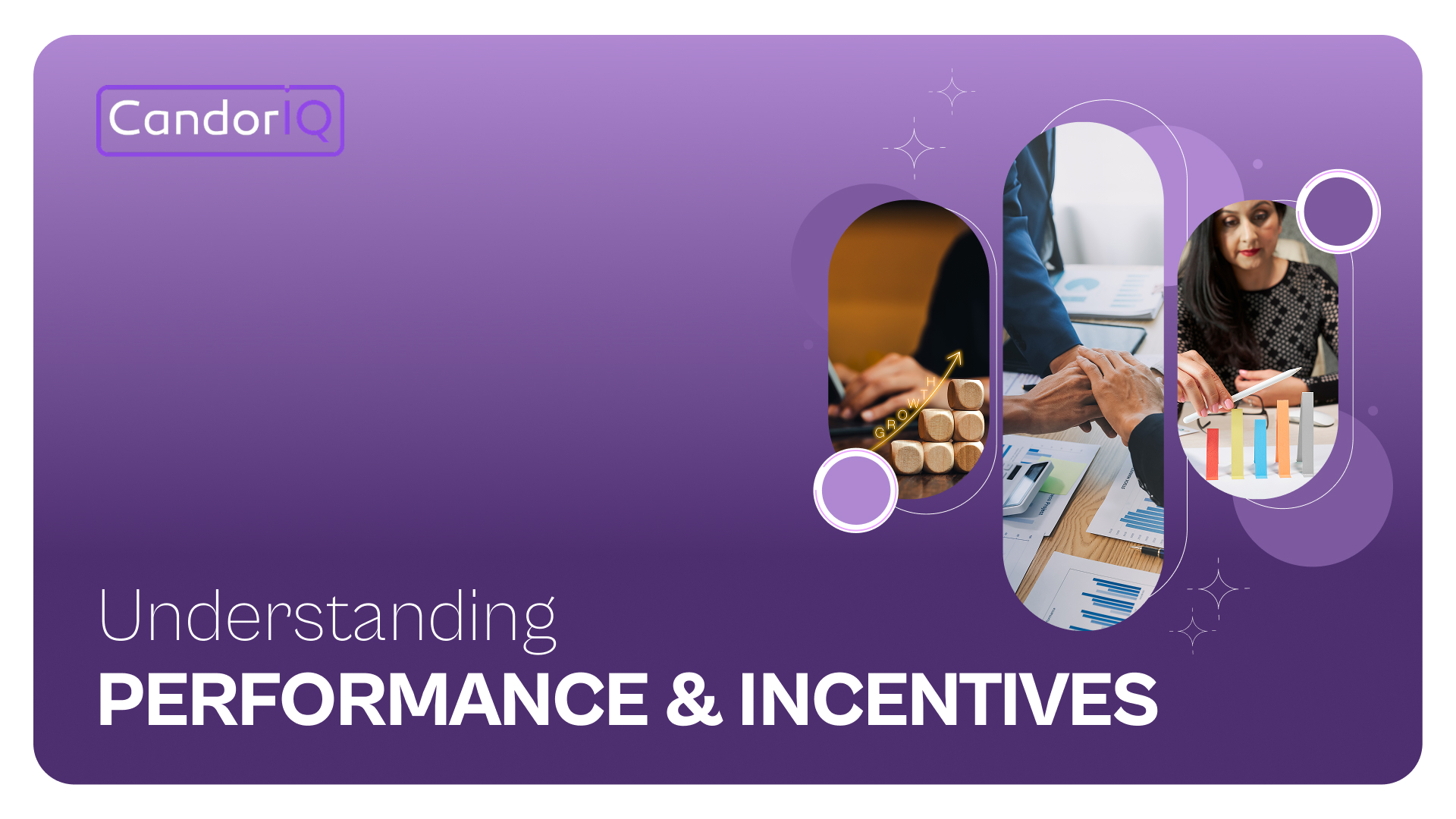
What if your compensation plan didn’t just reward employees for showing up, but actually motivated them to exceed expectations? Employees love a culture where the highest achievers are recognized, and everyone knows exactly how their effort impacts their success.
But designing a performance pay system that works? It’s easier said than done. As HRBPs and people managers, you face the challenge of aligning pay with performance without creating confusion, bias, or frustration.
We will show you how to craft a performance pay and top management incentives strategy that aligns with both your business goals and your employees' motivations.
TL;DR
- Understanding Performance Pay: Performance pay links employee compensation to their performance, aligning individual and company goals.
- Types of Performance Pay: Various models like bonuses, merit-based raises, and commissions can be structured to motivate employees.
- How to Implement Performance Pay: Define clear goals, ensure fairness, and communicate the plan effectively across teams.
- Benefits for Employers: Boosts productivity, helps with talent retention, and provides employees with clarity on how their performance impacts their pay.
- Challenges in Implementation: Balancing fairness, avoiding unhealthy competition, and ensuring long-term focus are key concerns.
What is Performance Pay and Why It Matters?
Performance pay is a compensation system where employees are rewarded based on their individual performance or team achievements. This approach ties financial rewards, such as bonuses or raises, directly to the value an employee contributes to the company.
By aligning employee actions with company goals, performance pay ensures that top performers are recognized and incentivized to continue driving success.
The Benefits of Performance Pay for Employers and Employees
Adopting a pay-for-performance model offers benefits for both employers and employees, including:
For Employers

- Increases employee motivation and engagement: Linking compensation to performance encourages employees to stay focused on delivering their best results, directly boosting overall productivity.
- Helps attract and retain top talent: A well-structured performance pay system can help your company stand out in the job market, attracting high-performing candidates who are motivated by performance-based rewards.
- Aligns business goals with employee actions: Performance pay ensures that employees' efforts are directly tied to the company's goals, building a stronger sense of purpose and direction in their work.
- Provides clarity on compensation distribution: With a transparent approach to performance-based pay, employees understand how their compensation is determined, which helps prevent misunderstandings and promotes fairness.
For Employees
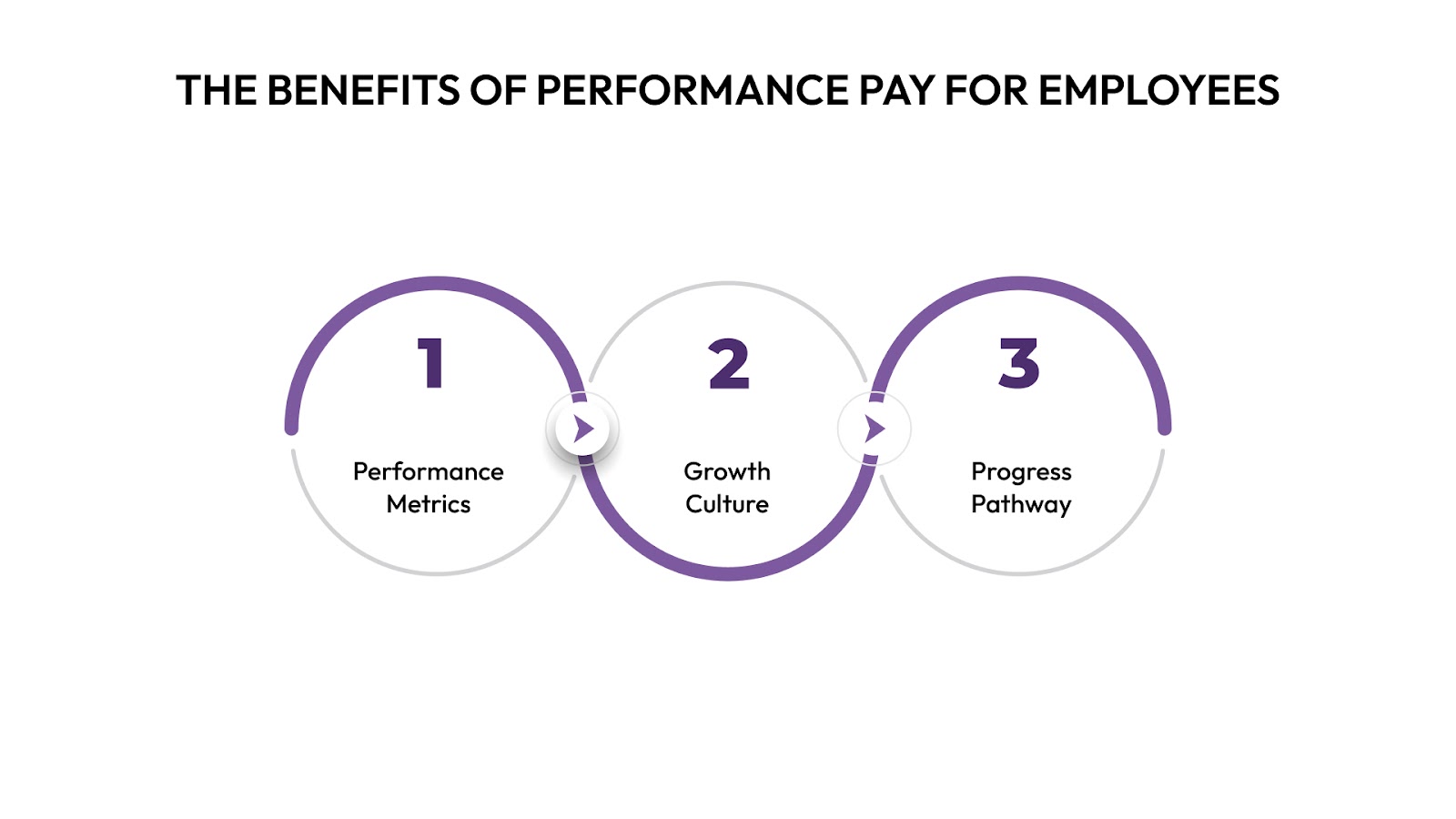
- Clear and measurable performance expectations: Employees know exactly what is expected of them and how their performance will be assessed, providing them with a clear path to success.
- Builds a culture of recognition and growth: When employees are rewarded for their achievements, it creates a positive environment where recognition and continuous improvement are valued.
- Helps employees understand the path to advancement and rewards: Performance pay provides a clear view of how employees can progress in their careers, both in terms of skill development and financial rewards.
As organizations seek to better their compensation strategies, the next step is to look into the diverse models of performance pay and top management incentives.
Types of Performance Pay and Top Management Incentives
Understanding the different types of performance pay and top management incentives is essential to creating a compensation plan that aligns with both employee goals and company objectives.
Each structure plays a unique role in motivating employees and driving business success.
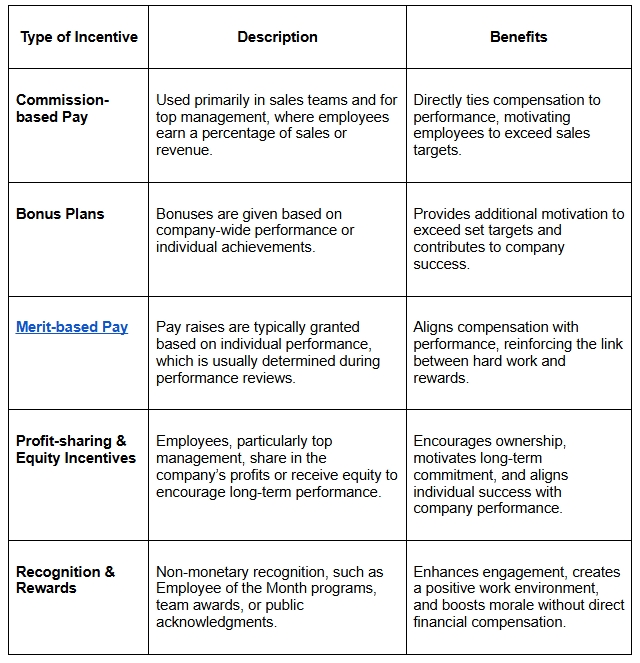
Selecting the right mix of these incentives ensures that both individual and team contributions are effectively rewarded.
Now, let’s understand the key steps in creating a system that aligns with your business goals and motivates employees effectively.
How to Implement Effective Performance Pay
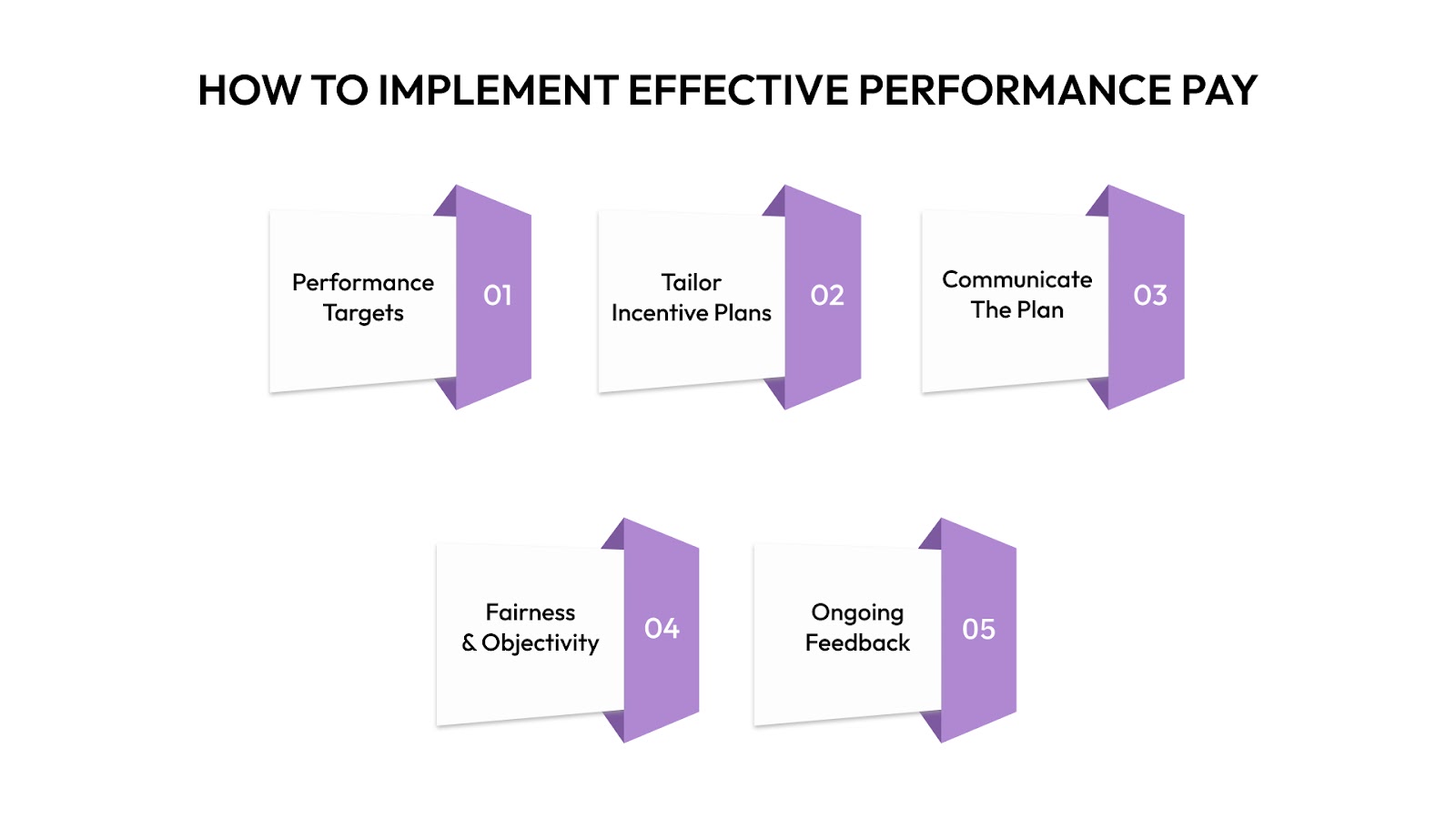
Implementing an effective performance pay system is essential. It aligns compensation with business objectives, ensuring that employee performance is properly recognized and rewarded.
The following steps will help you create a successful pay-for-performance system.
Step 1. Set Clear Performance Goals
Clear and measurable performance goals are the foundation of any performance pay system. These goals help employees understand how their efforts contribute to the company’s success and directly impact their compensation.
- Define SMART (Specific, Measurable, Achievable, Relevant, Time-bound) goals for employees at all levels.
- Ensure that these goals are aligned with the company’s overall business objectives and growth targets.
Step 2. Tailor Incentive Plans to Roles
Not all roles require the same type of incentive structure. Tailoring the compensation plan to the specific role ensures that incentives are effective and aligned with the job’s responsibilities and impact. For example:
- Sales teams benefit from commission-based pay or performance bonuses based on sales metrics.
- Top management is motivated by profit-sharing, equity incentives, or performance-based bonuses tied to company growth.
Step 3. Communicate the Plan
Effective communication is key to ensuring that employees fully understand the performance expectations and how they are tied to compensation. Transparency in the process helps build trust and motivation.
- Clearly explain how performance will be measured and how it impacts compensation.
- Regularly update employees on their progress toward goals and any changes in the performance pay structure.
Step 4. Fairness and Objectivity
Fairness in performance assessment is essential to avoid biases and ensure that all employees are treated equitably. Maintaining an objective approach in evaluating performance helps build trust and prevents resentment.
- Use standardized metrics to assess performance, ensuring consistency across all teams.
- Train managers to avoid biases and ensure objective, transparent evaluations.
Step 5. Regular Feedback and Adjustments
Regular feedback and adjustments to the performance pay system ensure its long-term success. This allows you to make data-driven decisions and optimize the program for better results.
- Conduct frequent performance reviews to assess progress and provide constructive feedback.
- Adjust the compensation plan to reflect employee performance and evolving business needs.
Implementing an effective performance pay system can bring great benefits, and by addressing common challenges, you can ensure it works even better. Let’s look at the challenges.
Challenges in Performance Pay Systems
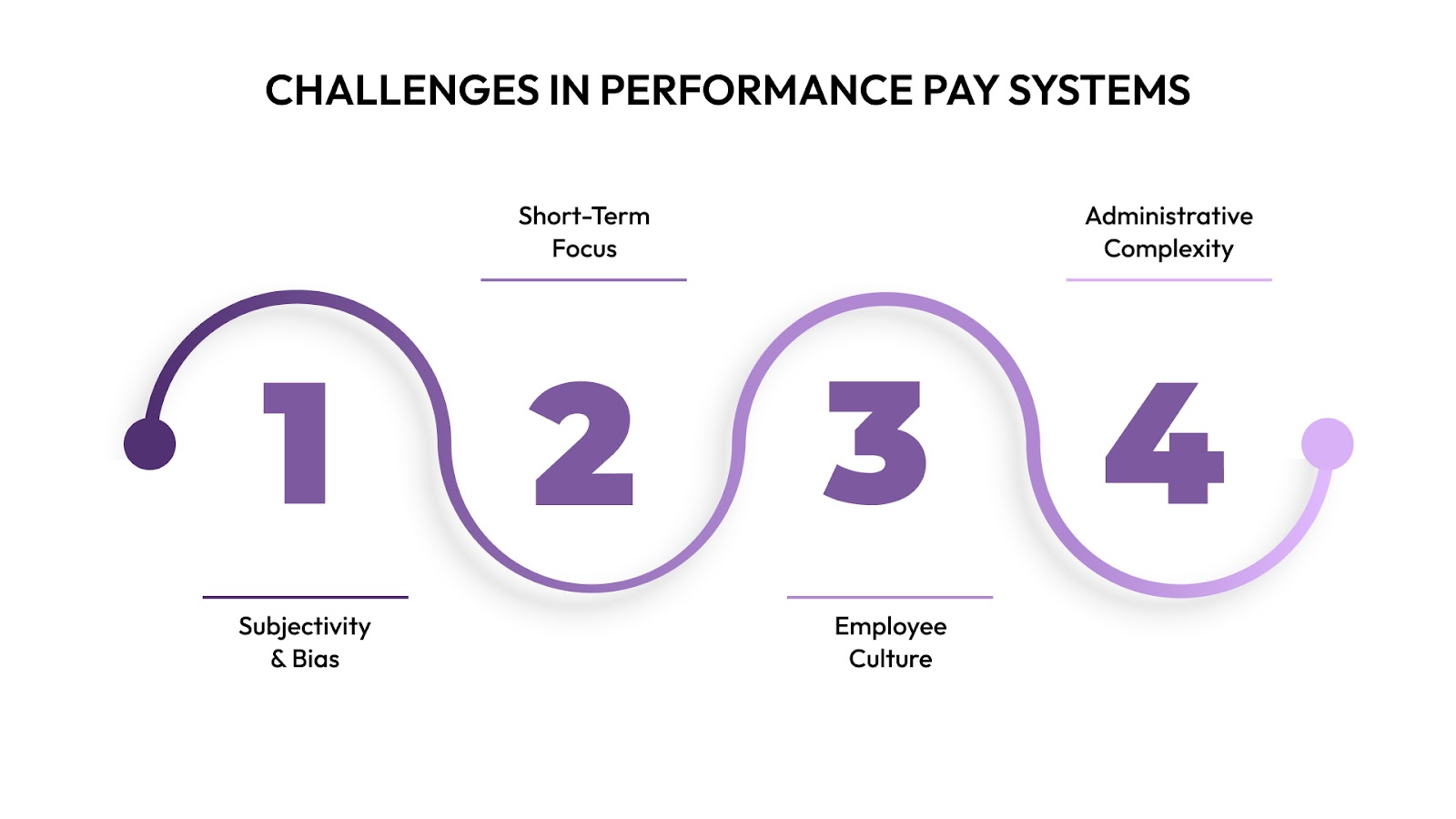
While performance pay and top management incentives can motivate employees, they also come with several challenges that must be addressed to ensure success.
1. Subjectivity and Bias
Performance reviews can sometimes be influenced by personal opinions or biases, leading to unfair pay decisions. This lack of objectivity can harm trust in the system and reduce its effectiveness, especially if employees feel they are being evaluated unfairly.
2. Short-Term Focus
Focusing too much on short-term goals can prevent long-term growth. Employees would prioritize immediate results, potentially sacrificing long-term success for quick wins. It's important to balance both short-term and long-term incentives.
3. Employee Morale and Team Dynamics
When individual performance is overemphasized, it can hurt teamwork. Employees might compete against each other instead of working together, which can reduce collaboration and harm overall team spirit.
4. Administrative Complexity
Managing performance pay systems can be complex for HR teams. From setting clear goals to tracking performance fairly, the process can be time-consuming and requires consistent effort to ensure fairness and alignment with company goals.
CandorIQ solves these common challenges by simplifying and optimizing performance pay management. Let's see how we can help you tackle them.
How CandorIQ Supports Performance Pay Management
Effective performance pay systems rely on accurate data, transparency, and smooth management. CandorIQ organizes these processes to ensure fair, competitive, and data-driven performance pay for your organization.
Compensation & Payband Builder
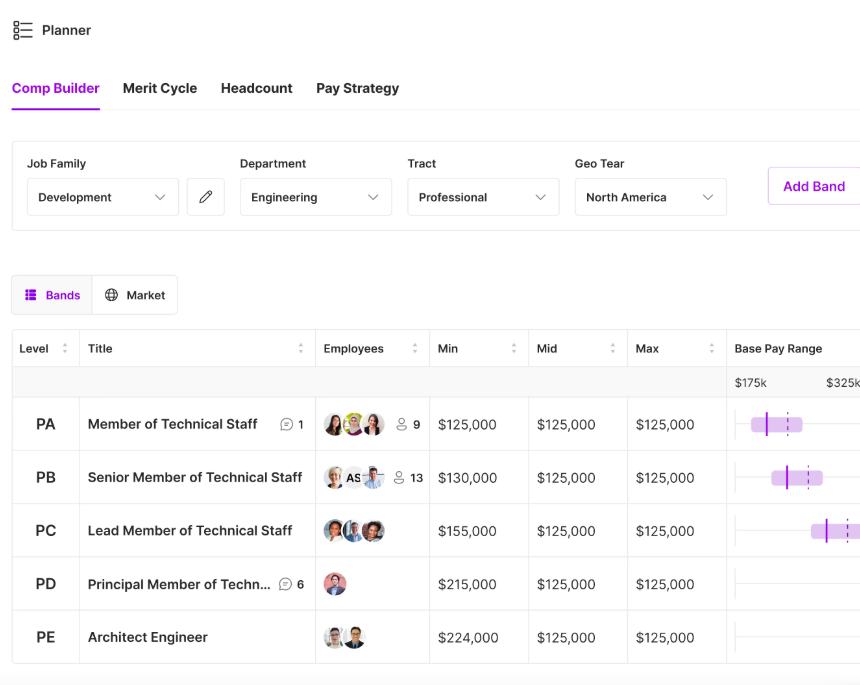
CandorIQ's Compensation management and pay band software simplifies the creation and management of performance pay systems by enabling you to define and adjust pay bands across various roles and departments.
With features like geo-adjusted salary benchmarking and pay distribution visualization, CandorIQ ensures that your performance pay scales remain competitive and aligned with industry standards. You can:
- Define pay bands by level, location, and department.
- Adjust pay based on location and benchmark data.
- Track pay band progressions over time for transparency and consistency.
Streamline your compensation management with CandorIQ’s Compensation & Payband Builder.
AI-powered Insights
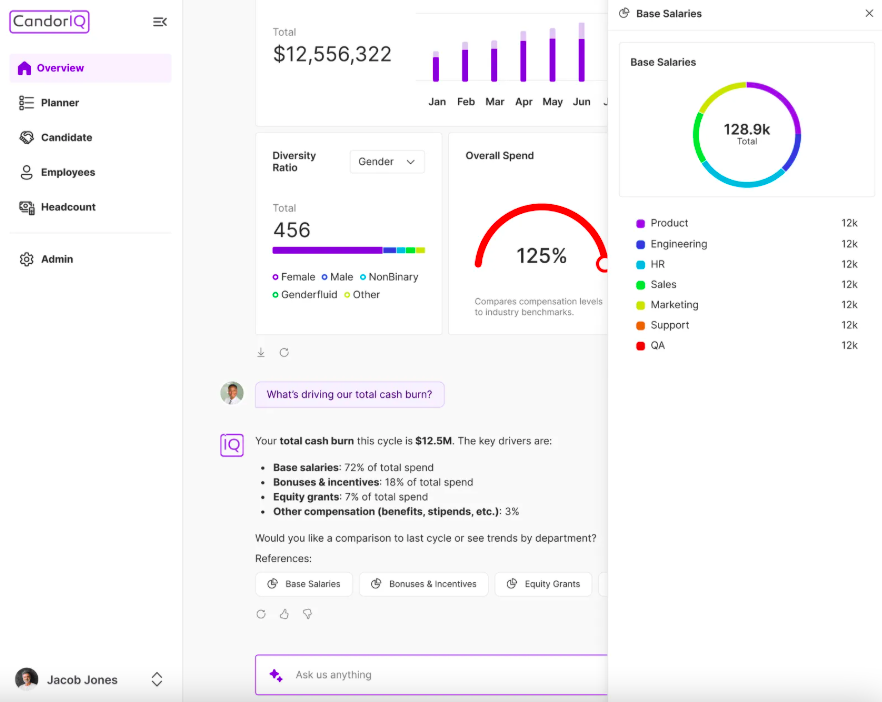
CandorIQ’s AI-powered agent is designed to help HR and finance teams make smarter, data-driven decisions regarding performance pay and top management incentives.
The agent makes it easy to optimize compensation strategies and improve workforce planning by:
- Uncovering pay equity gaps and offering suggestions for adjustments.
- Forecasting pay impacts based on employee performance and market trends.
- Providing proactive alerts on potential risks like budget overruns, pay disparities, or gaps in hiring.
Make data-driven decisions with AI-powered Insights. Book a demo today!
Integration with Existing HR Systems
CandorIQ integrates with your existing HRIS and ATS systems, providing a unified platform for managing all aspects of performance pay.
This integration ensures that employee performance data flows directly into compensation decisions. It allows HR teams to:
- Align hiring, promotion, and compensation decisions.
- Ensure consistency across departments with accurate performance data.
- Save time by automating manual data entry and performance tracking.
Transparency and Equity
CandorIQ prioritizes transparency, which is key for creating a fair and equitable performance pay system. It helps organizations communicate how compensation is linked to employee performance, offering a clear view of:
- Performance criteria tied to compensation.
- Historical and real-time data to track pay progressions.
- Transparent reporting for leadership and employees.
With CandorIQ, your organization can provide employees with clear visibility into how their performance impacts their pay, leading to greater trust and improved engagement across the workforce.
Final Thoughts
For many HR leaders and executives, managing performance pay and top management incentives can be a complex task, often marked by inconsistencies in compensation structures, a lack of clarity around performance metrics, and difficulties in ensuring fairness.
Without the right tools, these challenges can lead to frustration, disengagement, and a disconnect between employee performance and organizational goals.
CandorIQ offers features like performance-based pay structures, AI-driven insights, and seamless integration with your existing systems. This ensures that your performance pay strategy is fair, transparent, and aligned with business objectives.
Frequently Asked Questions (FAQs)
Q1. How can I ensure fairness in performance pay and top management incentives?
A1. Ensuring fairness requires using standardized evaluation criteria, consistent performance reviews, and performance evaluation software. Regular feedback and audits help reduce biases and ensure equitable compensation across all levels.
Q2. What are the risks of not aligning performance pay with company goals?
A2. Without alignment, employees focus on individual achievements rather than team goals, leading to decreased collaboration and hindered company performance. Clear alignment ensures that efforts contribute to the overall success.
Q3. How can I manage performance pay within budget constraints?
A3. Balancing performance pay within budget involves setting clear performance metrics tied to compensation and using compensation benchmarking. Regular reviews and forecasting help control costs while maintaining competitiveness.
Q4. How do performance pay systems impact employee retention?
A4. Well-structured performance pay systems can enhance employee retention by aligning compensation with achievements and growth opportunities. Transparent and competitive pay increases job satisfaction and loyalty, reducing turnover.
Q5. How often should performance pay metrics be reviewed and adjusted?
A5. Performance pay metrics should be reviewed at least annually to ensure they align with business goals, market trends, and employee expectations. Regular adjustments help keep the system relevant and effective in motivating performance.


